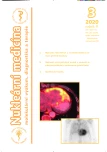The value of FDG PET/CT in the thromboembolic disease: review of the literature
Authors:
David Zogala
Authors‘ workplace:
Ústav nukleární medicíny, 1. lékařská fakulta Univerzity Karlovy a Všeobecná fakultní nemocnice v Praze, ČR
Published in:
NuklMed 2020;9:42-48
Category:
Review Article
Overview
The positron emission tomography combined with computed tomography (PET/CT) is a well established imaging modality in the oncological practice. The most frequently used radiopharmaceutical is 2-deoxy-2-(18F)fluoro-D-glucose (FDG). Due to the unspecific nature of its biodistribution it can also be used in the diagnosis of other clinical entities with increased metabolic turnover, especially in the inflammation and infection. Thromboembolic disease represents a relatively frequent and serious medical issue. Inflammatory and other hypermetabolic processes have substantial impact on its development. FDG PET/CT is not routinely used for its diagnosis, however direct or indirect signs of thromboembolic disease can be frequently encountered in the routine practice of PET/CT interpretation. This is a literature review analysing the role of FDG PET/CT in the primary diagnosis of thromboembolic disease, in the pulmonary hypertension evaluation, in the detection of the cause of unprovoked thromboembolic events and in the differentiation of tumor thrombus.
Keywords:
PET – Pulmonary hypertension – PET/CT – Positron emission tomography – thromboembolic disease – venous thrombosis
Sources
-
Tritschler T., Kraaijpoel N., Le Gal G. et al. Venous Thromboembolism: Advances in Diagnosis and Treatment. JAMA 2018;15 : 1583–1594
-
Hess S., Frary E. C., Gerke O. et al. FDG-PET/CT in venous thromboembolism. Clinical and Translational Imaging 2018;5 : 369–378
-
Line B. R. Pathophysiology and diagnosis of deep venous thrombosis. Semin Nucl Med 2001;2 : 90–101
-
Rondina M. T., Lam U. T., Pendleton R. C. et al. (18)F-FDG PET in the evaluation of acuity of deep vein thrombosis. Clin Nucl Med 2012;12 : 1139–1145
-
Hara T., Truelove J., Tawakol A. et al. 18F-fluorodeoxyglucose positron emission tomography/computed tomography enables the detection of recurrent same-site deep vein thrombosis by illuminating recently formed, neutrophil-rich thrombus. Circulation 2014;13 : 1044–1052
-
Le Roux P. Y., Robin P., Delluc A. et al. Performance of 18F fluoro-2-desoxy-D-glucose positron emission tomography/computed tomography for the diagnosis of venous thromboembolism. Thromb Res 2015;1 : 31–35
-
Miceli M., Atoui R., Walker R. et al. Diagnosis of deep septic thrombophlebitis in cancer patients by fluorine-18 fluorodeoxyglucose positron emission tomography scanning: a preliminary report. J Clin Oncol 2004;10 : 1949–1956
-
Flavell R. R., Behr S. C., Brunsing R. L. et al. The incidence of pulmonary embolism and associated FDG-PET findings in IV contrast-enhanced PET/CT. Acad Radiol 2014;6 : 718–725
-
Rondina M. T., Wanner N., Pendleton R. C. et al. A pilot study utilizing whole body 18 F-FDG-PET/CT as a comprehensive screening strategy for occult malignancy in patients with unprovoked venous thromboembolism. Thromb Res 2012;1 : 22–27
-
Alfonso A., Redondo M., Rubio T. et al. Screening for occult malignancy with FDG-PET/CT in patients with unprovoked venous thromboembolism. Int J Cancer 2013;9 : 2157–2164
-
Klein A., Shepshelovich D., Spectre G. et al. Screening for occult cancer in idiopathic venous thromboembolism - Systemic review and meta-analysis. Eur J Intern Med 2017 : 74–80
-
Galie N., Humbert M., Vachiery J. L. et al. 2015 ESC/ERS Guidelines for the diagnosis and treatment of pulmonary hypertension: The Joint Task Force for the Diagnosis and Treatment of Pulmonary Hypertension of the European Society of Cardiology (ESC) and the European Respiratory Society (ERS): Endorsed by: Association for European Paediatric and Congenital Cardiology (AEPC), International Society for Heart and Lung Transplantation (ISHLT). Eur Heart J 2016;1 : 67–119
-
Ahmadi A., Ohira H., Mielniczuk L. M. FDG PET imaging for identifying pulmonary hypertension and right heart failure. Curr Cardiol Rep [online]. 2015;1[cit. 22.4.2020]. DOI: 10.1007/s11886-014-0555-7.
-
Hagan G., Southwood M., Treacy C. et al. (18)FDG PET imaging can quantify increased cellular metabolism in pulmonary arterial hypertension: A proof-of-principle study. Pulm Circ 2011;4 : 448–455
-
Wang L., Li W., Yang Y. et al. Quantitative assessment of right ventricular glucose metabolism in idiopathic pulmonary arterial hypertension patients: a longitudinal study. Eur Heart J Cardiovasc Imaging 2016;10 : 1161–1168
-
Li W., Wang L., Xiong C. M. et al. The Prognostic Value of 18F-FDG Uptake Ratio Between the Right and Left Ventricles in Idiopathic Pulmonary Arterial Hypertension. Clin Nucl Med 2015;11 : 859–863
-
Kluge R., Barthel H., Pankau H. et al. Different mechanisms for changes in glucose uptake of the right and left ventricular myocardium in pulmonary hypertension. J Nucl Med 2005;1 : 25–31
-
Sakao S., Daimon M., Voelkel N. F. et al. Right ventricular sugars and fats in chronic thromboembolic pulmonary hypertension. Int J Cardiol 2016 : 143–149
-
Jansa P., Aschermann M., Chronická plicní hypertenze. Praha, Maxdorf, 2017, 380 p
Labels
Nuclear medicine Radiodiagnostics RadiotherapyArticle was published in
Nuclear Medicine

2020 Issue 3
Most read in this issue
- Role of scintigraphic procedures in patients with heart failure and preserved ejection fraction
- The value of FDG PET/CT in the thromboembolic disease: review of the literature
- What can you see on the image?
